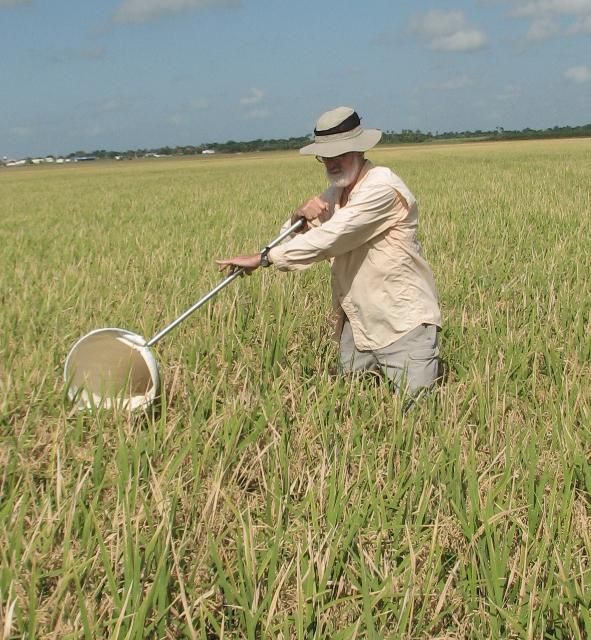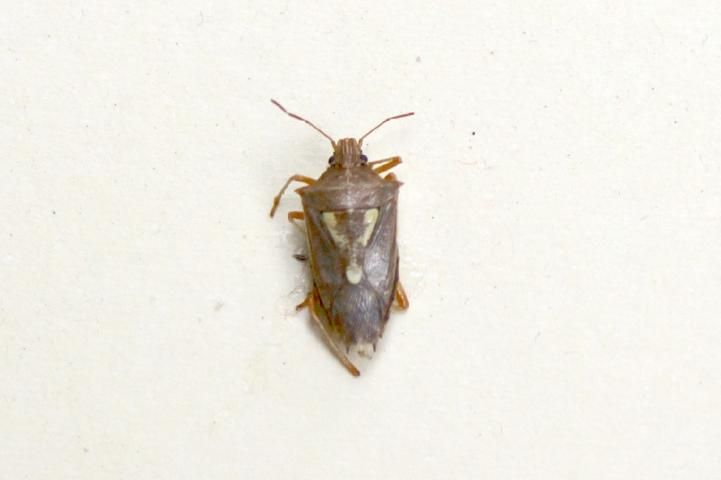Introduction
Although many different insects can be found in rice fields in Florida, stink bugs are currently considered the most important pest. Jones and Cherry (1986) reported that the rice stink bug, Oebalus pugnax, was the dominant species, comprising more than 95% of the total stink bug population. Cherry et al. (1998) reported that the stink bug Oebalus ypsilongriseus was widespread in Florida rice fields. This was the first report of this species being found in commercial rice fields in the United States. Cherry and Nuessly (2010) reported that the stink bug Oebalus insularis was widespread in Florida rice fields. This was the first report of this species being found in commercial rice fields in the United States. O. insularis has now become the most abundant stink bug in Florida rice (VanWeelden et al. 2020). The stink bug complex attacking Florida rice is the most diversified and unique stink bug complex in US rice production (Table 1).

Credit: UF/IFAS
Damage
Rice stink bugs cause economic losses in two major ways. Both the adult and nymphal stages feed on individual grains of rice as the panicle develops. With their sucking mouthparts, they can completely remove a grain's content in the milk stage of grain development, thereby reducing yields. More seriously, grains attacked in the dough stage become shriveled kernels with spots varying from light yellow to black. This condition, called "pecky rice," has the greatest impact on rice quality and marketability. Research has shown that much of the pecky rice is due to kernel wounding by the feeding behavior of the rice stink bug. This wounding introduces fungi and other microorganisms that cause the undesirable discoloration (peck) in the grain.
Biology
A large complex of these shield-shaped bugs occurs on rice. They are particularly fond of the developing grain of rice, other small grains, and various developing grass seeds. While a few species are almost specific to graminaceous plants, some species are equally fond of legumes and other crops. All of these bugs are similar in their life histories and habits. They have a gradual metamorphosis from egg through nymphal instars to adult. Nymphs of most species tend to be more colorful than adults. Nymphs become progressively larger with each molt, and the wing pads become progressively more prominent. All species share the protective ability to emit an ill-smelling substance from ventrally located osteolar canals (Genung et al. 1979).

Credit: UF/IFAS
Natural Control
Stink bugs have many general and specific natural enemies. Rice stink bug eggs are often attacked by egg parasites, particularly Telonomus sp. (Scelionidae). Stink bugs are also attacked by a variable group of insect predators. A benbicid wasp (Bicyrtes quadrifasciata) provisions its subterranean nests with green stink bugs and other pentatomids. The assassin bug (Zelus bilobus) feeds on nymphs as well as adults. Among several species of spiders that prey on stink bugs, a common jumping spider (Phidippus audax) is especially prominent.
Many species of birds feed to some extent on stink bugs. Data based on stomach contents analysis showed that 14% of meadowlark (Sturnella magna), 10% of red-winged blackbird (Agelaius phoeniceus), 16% of boat-tailed grackle (Cassidix mexicanus), and 14% of cattle egret (Bubulcus ibis) stomachs contained these insects (Genung et al. 1979). These data may look impressive, but they do not show evidence that bird predation is reducing stink bug populations significantly. More recently, Borkhataria et al. (2012) used bird exclosures to evaluate the effects of blackbirds on stink bug populations in Florida rice. There was no difference in abundance of rice stink bugs (Oebalus spp.) in environments where blackbirds had been excluded versus control environments, indicating that predation by birds did not reduce stink bug populations. Pecky rice damage rates in exclosure environments and control environments were similar as well. These data suggest that despite their conspicuous presence, blackbirds had little effect on stink bug populations in Florida rice fields.

Credit: UF/IFAS
Cultural Control
Timing of planting date has shown positive results in keeping stink bugs away from crops at their most vulnerable time. Litsinger (1994) gives examples of planting dates being used to reduce insect damage of numerous rice pests including stink bugs. Data in Table 2 suggest that planting date could be used to move rice heading from the period of greatest flight activity, thus reducing stink bug populations in the rice. However, moving rice planting dates may pose other problems for rice growers. Planting rice too early may result in frost damage, and rice in Florida may alternate with other crops such as corn and sugarcane grown at different times on the same land. Hence, rice planting and harvesting are frequently timed in conjunction with these other crops. Our data suggest that changing the planting date can avoid stink bug damage in rice, but the planting date is frequently contingent upon other grower considerations, which often makes changing it difficult or impossible.
The effect of weeds on rice stink bug, O. pugnax, populations was studied in Florida rice fields (Cherry and Bennett 2005). Fall panicum, Panicum dichotomiflorum, was the most common grassy weed found in weedy areas of rice fields, and significantly more rice stink bugs were found in these weedy areas than were found in non-weedy areas in the fields. Large numbers of rice stink bugs also were found in unmowed roadsides containing heading weeds, especially coast cockspur, Echinochloa walteri. In contrast, few rice stink bugs were found in mowed roadsides, presumably because mowing prevented weed heading around rice fields. The Cherry and Bennett study showed that weed control helps reduce rice stink bug populations in Florida rice.
Chemical Control
Insect sweep nets should be used for sampling. Treat when there are 30 stink bugs per 100 sweeps during the first two weeks of heading and when there are 100 stink bugs per 100 sweeps until two weeks before harvest (LSU 2013).
Cherry and Deren (2000) studied the effect of time of day and weather conditions on sweep-net catches of stink bugs in Florida rice fields. Their data showed that except in rainy, stormy, or very windy conditions, time of day is not a significant factor in sweep-net catches of stink bugs in Florida rice fields. Also, air temperature and wind speed, except when very windy, generally had little effect on stink bug catches in sweep nets.
Rice fields in Florida were sampled for the rice stink bug O. pugnax to determine its spatial distribution in Florida rice (Foster et al.1989). This most important stink bug pest of Florida rice had an aggregated distribution. However, the grower practice of sampling ends of fields rather than the entire field is satisfactory because stink bug catches from the ends of the fields accurately predict the overall field populations of the stink bugs.
Insecticide applications currently used by Florida rice growers are effective. However, population reduction of stink bugs may be only temporary (Jones and Cherry 1986). Insecticide recommendations do change over time. Hence, growers should contact their local UF/IFAS Extension agent for currently labeled insecticides for stink bug control.

Credit: UF/IFAS
Two of the three rice stink bug species are invasive and had no information on insecticide efficacy against these pests in Florida rice. Hence, Cherry et al. (2018) conducted a study to provide this information. It might be assumed that closely related insects would be equally susceptible to an insecticide. However, different susceptibility of different stink bug species to insecticides occurs in agricultural crops (Takeuchi and Endo 2012). Other studies have shown that variation in susceptibility to insecticides can vary widely across insect species, even within the same genus (Vernon et al. 2008). Moreover, Guedes et al. (2016) noted that insecticide bioassays usually focus on a single species, particularly a single arthropod pest species. The authors report that this is grievously unrealistic because a single-species environment does not exist in nature, not even when only agroecosystems are considered. Multiple species bioassays are receiving increased attention in environmental studies, but not in arthropod pest management and related fields despite their potential importance (Guedes et al. 2016). Cherry et al. (2018) showed that five insecticides recommended for control of O. pugnax in Florida rice also had high efficacy for control of the other two invasive Oebalus species currently infesting Florida rice. These data are useful to Florida rice growers and may be of future use to rice producers in other states if either or both of the two invasive stink bugs spread into other rice producing states.
References Cited
Borkhataria, R., G. Nuessly, E. Pearlstine, and R. Cherry. 2012. "Effects of blackbirds (Agelaius phoenicius) on stink bug (Hemiptera: Pentatomidae) populations, damage, and yield in Florida rice." Florida Entomol. 95: 143–149
Cherry, R. and A. Bennett. 2005. "Effect of weeds on rice stink bug (Hemiptera: Pentatomidae) populations in Florida rice fields." J. Entomol. Science 40: 378–384.
Cherry, R., D. Jones, and C. Deren. 1998. "Establishment of a new stink bug pest, Oebalus ypsilongriseus (Hemiptera: Pentatomidae) in Florida rice." Florida Entomologist 81: 216–220.
Cherry, R., and G. Nuessly. 2010. "Establishment of a new stink bug pest, Oebalus insularis (Hemiptera: Pentatomidae) in Florida rice." Florida Entomologist 93: 291–293.
Cherry, R., and C. Deren. 2000. "Sweep net catches of stink bugs (Hemiptera: Pentatomidae) in Florida rice fields at different times of day." J. Entomol. Science 35: 490–493.
Cherry, R. and A. Wilson. 2011. "Flight activity of stink bug (Hemiptera: Pentatomidae) pests of Florida rice." Florida Entomologist 94: 359–360.
Cherry, R., C. Odero, M. Karounos, and J. Fernandez. 2018. "Insecticidal control for the rice stink bug (Hemiptera: Pentatomidae) complex found in Florida rice." J. Entomol. Sci. 53: 372–378.
Foster, R., R. Cherry, and D. Jones. 1989. "Spatial distribution of the rice stink bug (Heteroptera: Pentatomidae) in Florida rice." J. Econ. Entomol. 82: 507–509.
Guedes, R., G. Smagghe, J. Stark, and N. Desneux. 2016. "Pesticide-induced stress in arthropod pests for optimized integrated pest management programs." Ann. Rev. Entomol. 61: 43–63.
Genung, W. G., G. H. Snyder, and V. E. Green, Jr. 1979. "Rice field insects in the Everglades." Belle Glade Res. Rep. EV-1979-7. Gainesville: University of Florida Institute of Food and Agricultural Sciences.
Jones, D. B., and R. H. Cherry. 1986. "Species composition and seasonal abundance of stink bugs (Heteroptera: Pentatomidae) in southern Florida rice." J. Econ. Entomol. 79: 1226–1229.
Litsinger, J. 1994. "Cultural, mechanical, and physical control of rice insects," pp. 549–583. In E. Heinricks (ed), Biology and Management of Rice Insects. New York: John Wiley and Sons.
LSU Ag. Center. 2013. Louisiana Insect Pest Management Guide: Rice-2013 Guide.
Takeuchi, H. and N. Endo. 2012. "Insecticide susceptibility of Nezara viridula (Heteroptera: Pentatomidae) and three other stink bug species composing a soybean pest complex in Japan." J. Econ. Entomol. 105: 1024–1033.
VanWeelden, M. T., R. H. Cherry, and M. Karounos. 2020. “Relative abundance of the stink bug (Hemiptera: Pentatomidae) complex infesting rice in the Everglades Agricultural Area of Florida.” J. Econ. Entomol. 113: 1582–1585.
Vernon, R., W. van Herk, J. Talman, H. Saavedra, M. Clodius, and B. Gage. 2008. "Transitional sublethal and lethal effects of insecticides following dermal exposure to five economic species of wireworms (Coleoptera: Elateridae)." J. Econ. Entomol. 101: 367–374.
Relative abundance of stink bugs found in southern Florida rice fields in 2008 and 2009 (Cherry and Nuessly 2010).